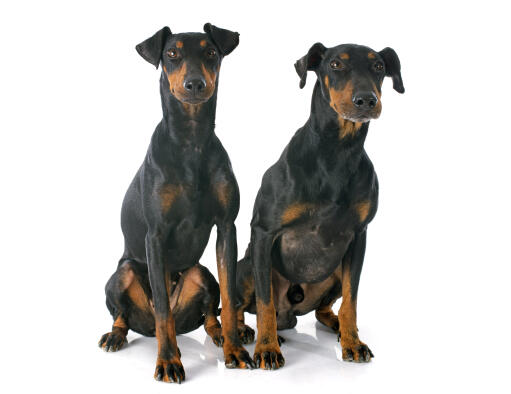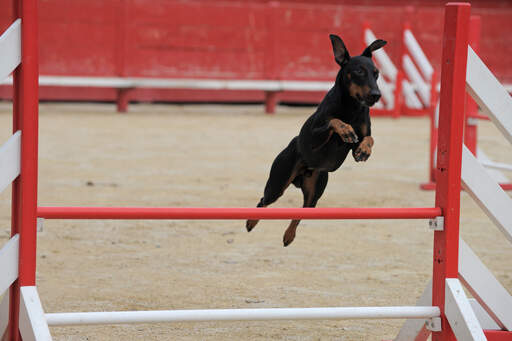Manchester Terrier Dogs









Breed Rating (1 Reviews)
| Appearance | |
| Friendliness | |
| Hardiness | |
| Garden |
History
The Black and Tan Terrier was a popular breed in the 16th century adept as rat catching. Whippet racing was also a popular pastime. Eventually the two breeds who crossed to produce the Manchester Terrier in the mid 1800's. The resulting dogs produced large and small Terriers; the standard is 12 - 22 pounds, with the Toy being under 12 pounds. Excelling at vermin control, these sleek dogs soon became popular. (In England the Toy is classed as the 'English Toy Terrier' not the Toy Manchester Terrier).
Behaviour
The Manchester Terrier is a devoted and affectionate dog who loves being around their family. They are described as catlike as they are a very clean breed. They can be reserved with strangers, but are usually ok with children and other dogs within the home, if raised with them. Some get on with cats, some don't. They like to bark and make good watch dogs, but the 'quiet' command should be taught early on. Manchester Terriers can be sensitive and dislike being left alone for too long. They will bark, chew and dig if they are bored, so the best prevention is to tire them out. Family pets such as rabbits, hamsters and gerbils stand little chance living with this breed. Manchester Terriers are more responsive to commands than many other breeds of Terrier, they learn quickly, but can be stubborn. They are sensitive to harsh words and can sometimes be snappy if not left alone, so caution is advised with very young children in the house. They are clever dogs and picks things up quickly, but they are head strong and protective, so need a firm hand to let them know who is boss. They excel at agility, Flyball and obedience and love the human attention, so making learning fun will help training sessions. They have a willingness to please you which makes training slightly easier. Like many Terriers, Manchesters have a lot of energy and need regular walks. Recall can be hit and miss due to their prey drive, but is usually better than most. Walking on a lead or secure area is recommended to prevent them dashing off after a rabbit or squirrel. Long walks will tire them out and prevent problems in the home, if left alone. They will need a soft bed to sleep in, but will prefer to snuggle up to you on the sofa given half a chance. Closeness is important to them and they are a loyal, responsive breed.
Their smooth coat needs little attention, just a regular brush to remove dead hairs. They suffer little in the way of health concerns, but cardiomyopathy is sometimes associated with the breed.
Temperament
Manchester Terriers have a stubborn and independent temperament. Like most terriers they are high energy and very self confident. This means you must provide plenty of praise and reward based training in order to gain respect from this feisty breed.
Around the house they should be well mannered but any small animals will be seen as prey and any strangers will be seen as a threat to their territory so at the very least they will be reserved and suspicious if not down right rude.
Health Problems
Health problems that may affect the Manchester Terrier include Legg–Calvé–Perthes disease (breakdown of the femoral head which can cause lameness and joint swelling), canine hip dysplasia (CHD), elbow dysplasia, luxating patella (dislocation of the knee cap), heart disease, eye problems and epilepsy.
Breed Details
- Status: Common
- Life Expectancy: 14 - 18 years
- Weight: 5.4 - 10 kg
- Height: 15 - 16"
- Rare: No
- Coat: Short
- Grooming Requirements: Once a week
- Town or Country: Either
- Minimum Home Size: Small House
- Minimum Garden Size: Small to Medium Garden
- Breed Type: Pest Control Dog
- Size: Medium
- Energy Level: High
- Exercise Required: Up to 1 hour
Manchester Terrier Pictures
Latest Reviews For Manchester Terrier (1 of 1)
Manchester Terrier/Chihuahua mix - Ladonna,
In reading about the breed, my dog has all of these traits. He is very affectionate, wanting to sleep right up next to us. Feisty, loves squirrels, eats good and has had no health problems until recently. He is 10 years old and has developed hip problems.













